Joseph Salvatore Ackley • Institute of Fine Arts, New York University
Recommended citation: Joseph Salvatore Ackley, “Copper-Alloy Substrates in Precious Metal Treasury Objects: Concealed and Yet Excessive,” Different Visions: New Perspectives on Medieval Art 4 (2014). https://doi.org/10.61302/BFJJ2322.
The two sides of the Borghorst reliquary cross, repoussé obverse and engraved reverse, present an appearance of gold, as does the cast key of St. Servatius in Maastricht and the cast Gozbertus thurible in Trier (Figures 1, 2, 3, and 4). All intend to glitter as gold, and yet their substances vary remarkably: the Borghorst obverse is gold sheet, the Borghorst reverse gilt copper-alloy, the St. Servatius key gilt silver, and the Gozbertus thurible gilt copper-alloy. The gilding of the Servatius key was recently removed, and now its silver substrate shines; the most recent publications, however, reproduce its gilt-silver iteration.[1] This essay asks if, when, and how the concealed substrates of these precious-metal liturgical objects would have come to matter publicly, and it marks the first step of a much larger project. Were medieval subjects seeing beneath the surface, or did a gold surface sufficiently satisfy and thus arrest their gaze, or did these precious-metal objects prompt a viewing mode at once penetrating and willingly beguiled?
Theophilus, for one, saw work, skill, and process in addition to the finished form, events prior to and yet still evident in the completed object. The Benedictine metalworker prefaces the three books of his De diversis artibus, most likely written in the mid- to late 1120s, by defending the making of sumptuous liturgical objects and images (neither category distinct) and prescribing their ideal operation.[2]Theophilus’s language entwines object, image, substance, surface, and also facture with both seeing and examining (perscrutare). Images and likenesses (imago, effigies, and similitudo) populate his writing, but Theophilus directs his viewer’s gaze equally, if not more so, towards work, works, and workmanship, all translations of opus.[3] Theophilus does begin the first book of his treatise by discussing man, created in the image and likeness of God (ad imaginem et similitudinem Dei), through whose imago man is able to accrue and practice, freely, wisdom and skill.[4] But as Theophilus moves to the primary content of his treatise—the making of paintings, stained glass, and precious-metal liturgical objects—he consistently pushes the work, opus, to the fore.

1. Borghorst reliquary cross, obverse, German (Essen?) with Fatimid rock crystal, gold (on obverse), gemstones, rock crystal, pearls, gilt copper (on reverse), wooden core, 41.1cm, ca. 1050. Steinfurt-Borghorst, Pfarrgemeinde St. Nikomedes (photo: ©Stephan Kube, Greven, Germany)
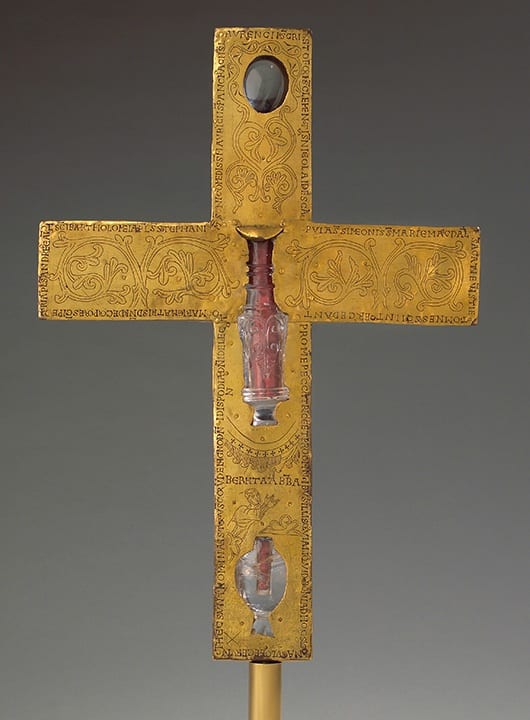
2. Borghorst reliquary cross, reverse, German (Essen?) with Fatimid rock crystal, gold (on obverse), gemstones, rock crystal, pearls, gilt copper (on reverse), wooden core, 41.1cm, ca. 1050. Steinfurt-Borghorst, Pfarrgemeinde St. Nikomedes (photo: ©Stephan Kube, Greven, Germany).
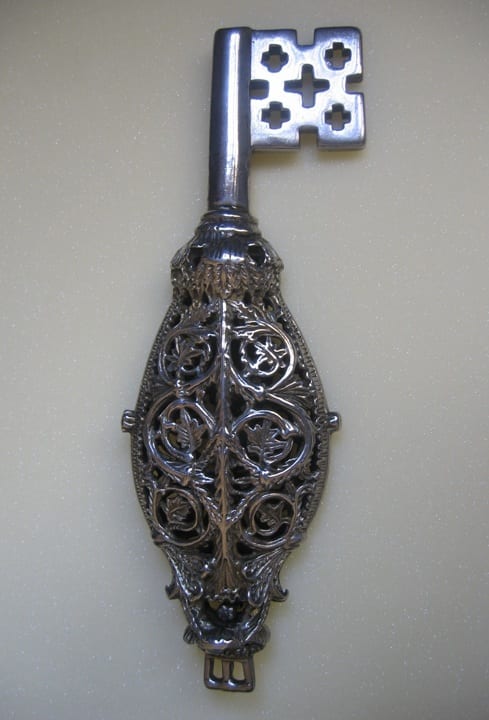
3. Key of St. Servatius, Aachen, Workshop of the Pfalzkapelle Bronze Railings, gilt silver, 29cm, ca. 800. Maastricht, Schatkamer Sint Servaas (photo: © Stichting Schatkamer Sint Servaas).
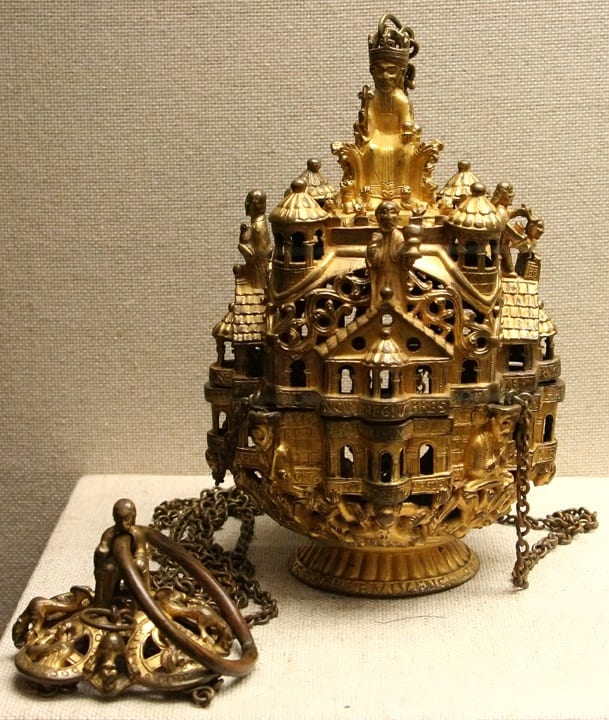
4. Gozbertus Thurible, Trier, gilt copper-alloy, 22cm, early 1100s. Trier, Domschatz (photo: © Holly Hayes/Art History Images).
Such extensive esteem of opus, however, does not preclude select occasions when Theophilus prioritizes the imaginem or effigiem. When justifying lavish church decoration in the preface to the third book, Theophilus cites, among other sources, the Psalmic poetry of David, most prominently Vulgate Psalm 25:8, “Lord, I have loved the beauty of thy house” (Domine, dilexi decorum domus tuae). He then prescribes an example of such decoration, beginning with examples of opus before transitioning to an effigies of transformative potential:
For the human eye is not able to consider on what work first to fix its gaze; if it beholds the ceilings they glow like brocades; if it considers the walls they are a kind of paradise; if it regards the profusion of light from the windows, it marvels at the inestimable beauty of the glass and the infinitely rich and various workmanship. But if, perchance, the faithful soul observes the representation of the Lord’s Passion expressed in art, it is stung with compassion.[5]
We move from ceilings and walls, likened to brocades and paradise, to windows, whose decorative programs remain unmentioned as Theophilus extols their beauty and “infinitely rich and various workmanship” (operis pretiosissimi uarietatem), a phrase recalling the importance of varietas in images and objects to the Carolingians and early medieval subjects in general.[6] These objects establish a setting, within which the following then becomes possible, as translated by Dodwell, with flair: “But if, perchance, the faithful soul observes the representation of the Lord’s Passion expressed in art, it is stung with compassion” (Quod si forte Dominicae passionis effigiem liniamentis expressam conspicatur fidelis anima, compungitur). An effigiem can strike the soul. The question of how Theophilus distinguishes between and evaluates the spiritual efficacy of objects and images, or of opus and effigies, even as those two categories blur together in both his writing and the objects made per his teaching, and the question of whether a hierarchy obtains, particularly regarding which object-images are able to “sting” the viewer, remains an open question beyond the scope of this discussion.
A final passage to consider from De diversis artibus sees Theophilus exhorting his viewer to examine (perscrutare) the methods of manufacture to be discussed, stoking anticipation with a sampling of such ornamenta. He does not leave these objects within the somewhat de-historicized realm of Biblical exegesis and Davidic poetry—instead, he grounds them in contemporary geographies and codes them, fervently, exceptionally, and delightfully, via the crafts responsible for such precious and monumental church decoration:
If you [the reader] will diligently examine it [the treatise], you will find in it whatever kinds and blends of various colours Greece possesses: whatever Russia knows of workmanship in enamels or variety of niello: whatever Arabia adorns with repoussé or cast work, or engravings in relief: whatever gold embellishments Italy applies to various vessels or to the carving of gems and ivories: whatever France esteems in her precious variety of windows: whatever skilled Germany praises in subtle work in gold, silver, copper, iron, wood and stone.[7]
This interweaving of craft and place—a geography proudly embracing not only Latin and Greek Christendom but also the non-Christian Eastern neighbor—culminates with Theophilus’s homeland of Germania, whose work is categorized into the familiar hierarchy of gold, silver, copper (cupri), iron, wood, and stone.[8] The catalogued opera remind us that, throughout his treatise, Theophilus esteems, rewards, and carves out discursive space for the appreciation and seeing of opus.
Theophilus’s audience may be broadly categorized into two groups, namely, those who crafted these objects and those most complicit in their commissioning, use, storage, and sometime destruction. The latter group was invested, either consciously or indirectly, in such considerations as the type and purity of the precious metals used, the costs of labor, the prestige generated, liturgical propriety, and so on. Therefore, in evaluating whom Theophilus’s models of seeing opus might implicate, we may plausibly argue for a slightly larger audience than select peer monastics. Using Michael Camille’s tiered model of medieval literacy, we may assume the circulation of some knowledge of fine metalworking, including both material and technique, among the members of the economic elite.[9] A chalice rendered costly by its material and decoration could thus have been read as such not only by those who possessed the chalice but also by those economically implicated by the proximal storage of such luxury.
Armed with this model of seeing both form and facture, let us return our attention to the Borghorst cross, the key of St. Servatius, and the Gozbertus thurible, and specifically their copper-alloy substrates. Putting aside, momentarily, the issue of their gilt surfaces, the copper-alloy substrates of the cast Gozbertus thurible and the engraved Borghorst cross reverse open into a tangled intellectual and practical medieval history of the elite conceptualization, public understanding, and shifting visibility of copper and its alloys. Medieval copper alloys range terrifically in composition, appearance, and physical behavior. Unlike the relatively straightforward categories of gold and silver (aurum and argentum), the medieval understanding of copper alloys developed gradually over centuries.[10] The attendant vocabulary is semantically inconsistent, and across natural histories, encyclopedias, and metalworking treatises there arises a sometimes striking gulf between the knowledge recorded via writing and the much more detailed practical knowledge embodied by the metal objects themselves. Modern scholarship on copper alloys (most all of which are technically quaternary alloys of copper, zinc, tin, and lead) reflects these semantic inconsistencies. As Otto Werner demonstrated, much medieval metalwork traditionally referred to as “bronze” is technically brass.[11] Today, “brass” usually signifies copper alloyed primarily with zinc, and “bronze,” generally, copper alloyed with tin, although contemporary museum practice lacks strict definitions and specific concentration requirements.[12] Future deliberations of nomenclature remain.
Within medieval Latin, let us focus on three traditions, both practical and semantic, of copper alloys, those of aes, aurichalcum, and cuprum. These words can signify so radically that it seems almost misleading to pair them with their modern definitions of “bronze,” “brass,” and “copper.”[13] Aes covers the most spacious, most permeable category—although from at least Pliny it can clearly designate the copper-tin alloy we call “bronze,” it can also represent any impure metal ore other than silver or gold. Etymologically, aes develops first; Classical Latin sometimes modifies it adjectivally to mark key varieties. In Late Antiquity there eventually arises cuprum, “copper,” out of the Antique aes Cyprium, the aes of Cyprus, whose copper mines were renowned. Cuprum, though infrequently found in church treasury inventories, is the most fixed, most bounded of these three terms, and its definition solidifies by the time of Isidore.
The semantic vicissitudes of aurichalcum, which, like aes, predates cuprum, vary tellingly, and this restlessness appropriately reflects two key characteristics of pre-modern brass. First, on the practiced spectrum of copper alloys bronze and brass exist contiguously or even with overlap. Second, during the Middle Ages, the key alloying element in brass, zinc, was not a known metal—metallic zinc was first isolated only in the sixteenth century. Medievals produced brass from the zinc-rich ore calamine. As described by Theophilus, crushed calamine is layered with charcoal and impure copper, then roasted a few times at what we now know to be a temperature between 900 and 950 degrees Celsius. The boiling point for zinc, however, is 906 degrees Celsius, meaning that, during the cementation process, the zinc evaporates out of the calamine and is absorbed as a vapor into the surface of the still solid copper. The copper is then liquefied to distribute the new surface color evenly throughout. The resulting alloy behaves like the harder, golden-yellow brass that it is. However, as Stefan Krabath and others observe, and in a striking contrast to the early modern conception of brass, brass production was not understood by medievals to be the combination of two different metals. Rather, with zinc metal still unknown, smelting aurichalcum appeared to involve only the one metal, copper, that was roasted with calamine ore to turn it yellow. Brass was therefore considered colored copper, as opposed to bronze, which was observed and understood to be the combination of two separate metals, copper and tin.[14]
The literature is still working through the medieval uses of aes and aurichaclum. Even within highly literate texts by Theophilus and Albertus Magnus the use of aes vs. aurichalcum is inconsistent; in their translated versions of Theophilus, Hawthorne and Smith, in one translation, and Dodwell, in the other, treat the words differently, Dodwell even translating aes as “brass” and aurichalcum as “bronze.”[15] Werner, Pete Dandridge, and others, including Dodwell, suggest that Theophilus uses aes to describe a lead-rich brass and aurichalcum for brasses whose lead concentrations had been reduced, freeing them to take the standard fire-gilding (in lead-rich alloys the lead migrates to the surface and compromises the gilding).[16] Hawthorne and Smith translate, reluctantly, aes as “course brass.”[17] Ursula Mende recently argued that defining medieval aes as “bronze” is far too narrow and that it should remain a generic, catch-all “copper alloy” out of which aurichalcum and other metals occasionally arise.[18] In my reading, however, it appears that there are occasional patterns to the use of aes and aurichalcum that warrant further scrutiny.
This paper asks, however, why and how would these types of copper alloy matter and how we negotiate this relationship between substance and appearance, between being there vs. being apparent. Copper alloys certainly matter within metalworking practice, as workshops carefully tailored the concentrations of lead, tin, and calamine ore in their alloys to the ultimate form and function of the finished object.[19] William Oddy classifies twelfth-century Europe as a “sophisticated” metalworking environment practiced at such alloy control.[20] Extreme examples include the high-tin bronzes needed for bells or mirrors. Subtler but no less determinant parameters included whether the object was to be cast or cold-worked, and whether it was to be gilded. Overall, bronze and brass are better for casting than pure copper, and thus the Abdinghof portable altar rests upon gilded cast-bronze feet, while its sides are clad with engraved sheets of gilt copper (Figure 5).[21] Left uncovered, bronze and brass surfaces were esteemed for their rich patination.
But of course, frequently the goal was to conceal the copper alloy and make it substrate to a surface of gold or silver—the front of the Metelen bursa reliquary is gilt copper sheet (Figure 6).[22] The repeatedly reaffirmed hierarchy of gold-silver-bronze manifests itself across texts and objects alike. Isaiah 60: 16-17 reads as follows: “Then you will know that I, the Lord, am your Savior, your Redeemer, the Mighty One of Jacob. Instead of bronze I will bring you gold, and silver in place of iron. Instead of wood I will bring you bronze, and iron in place of stones.”[23] The Gauzelin chalice, which not only looks like gold but actually is crafted of cold-worked gold sheet, would perch at the top of this hierarchy (Figure 7), a step above, perhaps, the repoussé silver thuribles from Basel (Figure 8).[24] Were the Gauzelin chalice to have been inventoried in the tenth century, its entry would have read, bluntly, calix aureus. This phrase distills nicely the two main sides of the object’s material identity, namely, its object type, “chalice,” and its spectacularly prized substance, “gold.”
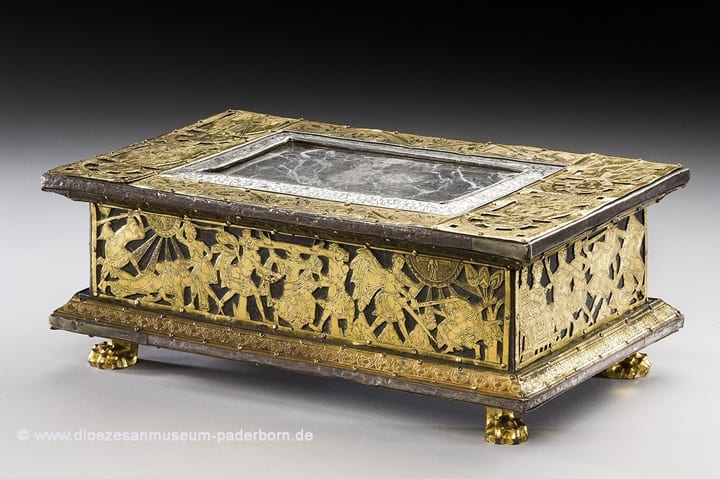
5. Roger of Helmarhausen, Abdinghof Portable Altar and Detail, oak core, gilt copper, gilt bronze, silver, 11.0 x 18.5 x 31.1cm, early 1100s. Paderborn, Erzbischöfliches Diözesanmuseum (photo: courtesy of Erzbischöfliches Diözesanmuseum Paderborn/Ansgar Hoffman).
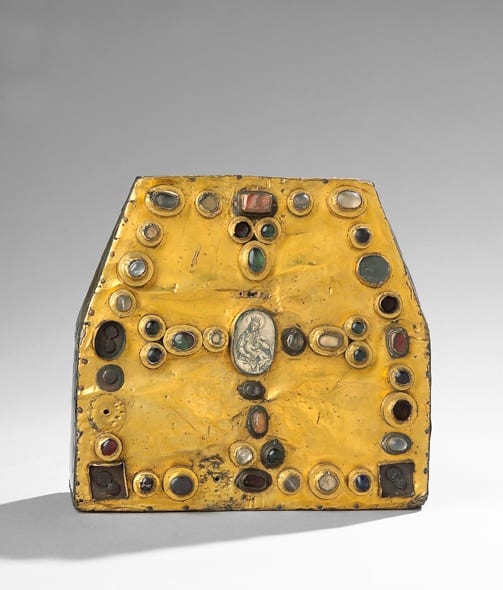
6. Bursa Reliquary, Westphalia, wooden core, gilt copper sheet, gemstones, pearls, Baroque-era additions, 21.4 x 22.4cm, 800s-900s (ca. 889?). Metelen, Kath. Kirchengemeinde St. Cornelius und Cyprianus (photo: © Stephan Kube, Greven, Germany).
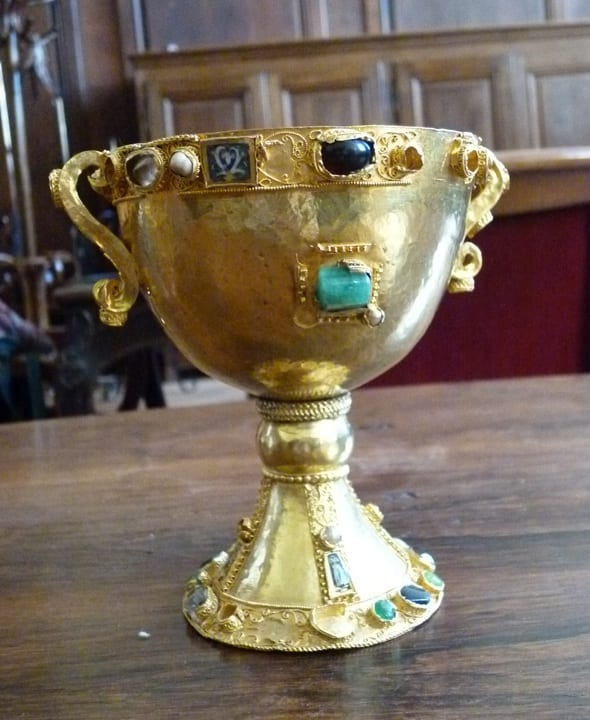
7. Chalice of Bishop Gauzelin, Lotharingia, gold, gemstones, pearls, cloisonné enamel, 13.2cm, mid-900s. Nancy (photo: © Beatrice Kitzinger).
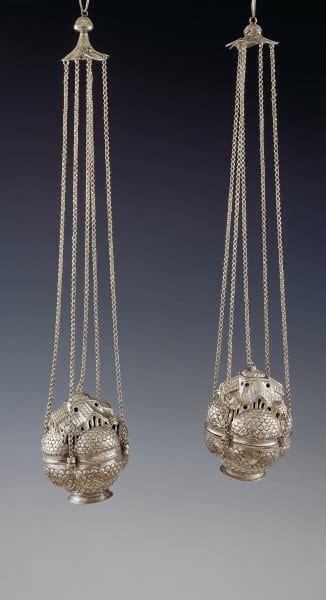
8. Two Thuribles, Upper Rhineland (Basel?), silver, vessel heights: 13.1cm and 13.4cm, ca. 1200. Basel, Historisches Museum (photo:© Historisches Museum Basel, 1882.82, 1916.516).
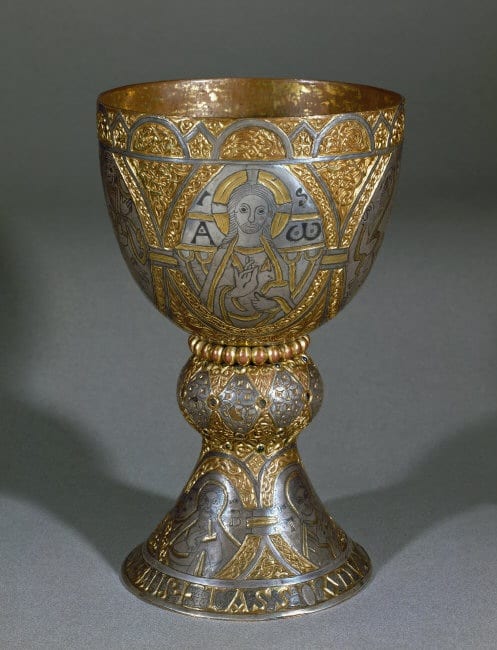
9. Chalice of Duke Tassilo, South Germany/Alemannic region (Salzburg?), gilt copper alloy, silver, niello, 27cm, ca. 777-788. Kremsmünster (photo: © Erich Lessing / Art Resource, NY).
But most treasury objects fell short of the simpler materialities of calix aureus and turribula duo argenta. The desired appearance and likeness, the wanted image, was thus constructed. The Tassilo chalice therefore fire-gilds (and thus hides) its copper-alloy and sports nielloed silver plaques as well to aspire to a costlier status (Figure 9).[25] And this introduces a latent instability not possible with the Gauzelin chalice: the Tassilo chalice, with its layered metals, performs rather successfully as a gold-and-silver chalice, and yet, as with any performance, there exists the possibility of breakdown. Prior to any ritual operation of the Tassilo chalice, there is performance. The Tassilo chalice exists via performance, a performance occasionally in danger of ceasing. The language of performance is particularly apposite to the material identities of these objects, specifically because these precious-surface objects operate, with intention, within the space between publicly witnessed social identity and the underlying, but still socialized and defined, substrate, between the publicly presented and the occasionally excessive hidden, between public and non-public matter.[26]
There happens to survive a treasury inventory from the Tassilo chalice’s home abbey at Kremsmünster drawn up shortly after 1013 during the tenure of Abbot Sigimar. Five chalices with patens are listed, four of silver, one gold. The Tassilo chalice’s gilded surfaces, with their Insular-influenced ornament and texture, resist reading as ground, and so it is unclear whether the inventory’s author considered the chalice to be gold or silver.[27] But either way the Tassilo chalice’s copper-alloy substrate has effectively disappeared within the representational space of the inventory. We must ask if this absence results from the expected conventional rhetorical strategy of “rounding up” these metal composites to the highest status possible. In the Gozbertus thurible at Trier we see gilt bronze, in the key of St. Servatius at Maastricht we see gilt silver. Why record “gilt bronze” when one strengthens the performance by bluntly documenting “gold?” But “gilt bronze” is precisely what the Kremsmünster inventory author does say when listing two thuribles, turribulum aureum, alterum eneum et deauratum, “a golden thurible, the other bronze and gilt.”[28] Therefore, when so desired, both “bronze” and “gilt” could be easily registered within the inventory space—and the Kremsmünster inventory is not at all exceptional in this regard—and one reasonably assumes that the inventory’s author, a cleric with privileged access to high-status metalwork, would have known anyway that beyond a gold and silver surface there frequently lay a “thingly excess,” namely, copper alloy. The disappearance of the Tassilo chalice’s copper alloy within the inventory space signals its continuing success, a fitting conclusion to the chalice’s material aspirations. And given the context of Carolingian-era Church proscriptions on the materials permitted to make chalices, through which aurichalcum and aes were forbidden (due to how their surfaces would adversely interact with wine), such a textual record conforms appropriately.[29]
![10. Lothar Cross, obverse, Rhenish (Cologne?), gold (obverse), gilt silver (reverse), gemstones, pearls, cloisonné enamel, antique cameo, Carolingian crystal, wooden core, 50cm, ca. 985-991. Domschatz Aachen (photo: © Domkapitel Aachen [photo: Ann Münchow]).](https://differentvisions.org/wp-content/uploads/sites/1356/2019/07/ackley-image10.jpeg)
10. Lothar Cross, obverse, Rhenish (Cologne?), gold (obverse), gilt silver (reverse), gemstones, pearls, cloisonné enamel, antique cameo, Carolingian crystal, wooden core, 50cm, ca. 985-991. Domschatz Aachen (photo: © Domkapitel Aachen [photo: Ann Münchow]).
![11. Lothar Cross, reverse, Rhenish (Cologne?), gold, gilt silver, gemstones, pearls, cloisonné enamel, antique cameo, Carolingian crystal, wooden core, 50cm, ca. 985-991. Domschatz Aachen (photo: © Domkapitel Aachen [photo: Ann Münchow]).](https://differentvisions.org/wp-content/uploads/sites/1356/2019/07/ackley-image111.jpeg)
11. Lothar Cross, reverse, Rhenish (Cologne?), gold, gilt silver, gemstones, pearls, cloisonné enamel, antique cameo, Carolingian crystal, wooden core, 50cm, ca. 985-991. Domschatz Aachen (photo: © Domkapitel Aachen [photo: Ann Münchow]).
But the copper-alloy substrate, latent and potential, could be exposed should the Tassilo chalice slip into a less successful, more dynamic state. A gilt surface, due to gold’s opacity and famous resistance to weathering, excellently covers its substrate to simulate “the real thing.” The two sides of the Borghorst cross, repoussé gold sheet on the front, gilt copper alloy on the back, do present, subtly, differences in luster and hue, but they approximate each other presumably well enough. More tellingly, when comparing the reverses of the Borghorst and Lothar crosses one is challenged to distinguish the Borghorst gilt copper-alloy from the gilt silver of the Lothar cross (Figure 11).[30] Furthermore, on both these Ottonian crosses the repoussé gold sheet is still placed and worked on the obverse, the gilt silver and gilt copper-alloy sheets on the reverse (Figure 10). Despite the golden surface that would appear to conceal the inner substance of each cross, a clear hierarchy of metals, a hierarchy dependent on knowledge of the material, obtains.
These hidden substrates matter precisely because the typical treasury object was conceived as something to be always at the ready to satisfy a set array of potential demands, many of them in competition. A precious-metal treasury object can be viewed as a temporary physical shaping, a manifestation contingent upon a variety of interests that momentarily intersect, among them ritual, visual, material, economic, legal, political, and otherworldly concerns. Among its many guises the metal treasury object served as frozen capital that could be melted down and rereleased into the economy. These economic complicities are exciting; they enrich our approach, and they point to some key moments of object breakdown. When an object was inventoried not as aureus but as deauratus, its copper-alloy substrate, even if unspoken, mattered. Ditto when an object was placed on a goldsmith’s scale to be assayed or judged worthy or not of being melted down.
But does the substrate only matter when such economic considerations are prioritized at the expense of the object’s other existential modes? Did the medieval consumer see a hidden copper-alloy only when specially prompted? I am arguing that these objects can cue their underlying matter even when stable. The lengthy inscription of the c. 1130 Radleuchter at Comburg records its composition of silver, iron, and gilt bronze, argento ferro confectus et aere sub auro—“bronze beneath gold,” not simple gold.[31] This phrase perhaps goes beyond documentary description: as William Diebold points out, Carolingian writers such as Hrabanus Maurus, quoting Cassiodorus, exegetically glossed the symbolism of the surface/substrate relationship in gilded bronze objects.[32] But given the divide between the normative knowledge of metals recorded by medieval thinkers and the knowledge practiced, when documentation lacks one still wonders just how diffuse this practical knowledge would have been among elite and non-elite audiences alike. Barbara Boehm tantalizingly notes that Limousin enamel chasses, all gilt-copper, were less valuable to the potential thief and thus less likely to be stolen (Figure 12). Either by sight or by handling the thief knew what to grab and what not to—but was sight or touch determinant?[33]
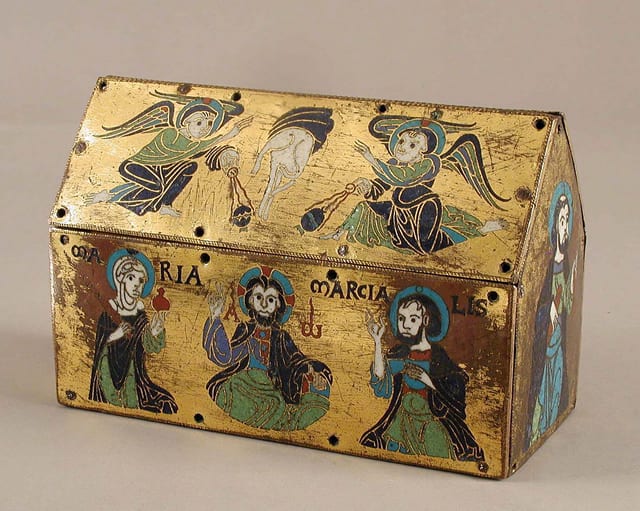
12. Chasse of Champagnat, Limoges, gilt copper, champlevé enamel, cloisonné enamel, 12.4 x 18.9 x 8.5cm, ca. 1150. New York, The Metropolitan Museum of Art (photo:© Metropolitan Museum of Art).
![13a. Scheibenkreuz, Hildesheim, bronze gilt, copper gilt, gemstones, 34cm diameter, ca. 1120-1140. Dom-Museum Hildesheim (photo: courtesy of Dom-Museum Hildesheim [photo: Joseph Salvatore Ackley]).](https://differentvisions.org/wp-content/uploads/sites/1356/2019/07/ackley-image13.jpeg)
13a. Scheibenkreuz, Hildesheim, bronze gilt, copper gilt, gemstones, 34cm diameter, ca. 1120-1140. Dom-Museum Hildesheim (photo: courtesy of Dom-Museum Hildesheim [photo: Joseph Salvatore Ackley]).
![13b. Scheibenkreuz, detail, Hildesheim, bronze gilt, copper gilt, gemstones, 34cm diameter, ca. 1120-1140. Dom-Museum Hildesheim (photo: courtesy of Dom-Museum Hildesheim [photo: Joseph Salvatore Ackley]).](https://differentvisions.org/wp-content/uploads/sites/1356/2019/07/ackley-image14.jpeg)
13b. Scheibenkreuz, detail, Hildesheim, bronze gilt, copper gilt, gemstones, 34cm diameter, ca. 1120-1140. Dom-Museum Hildesheim (photo: courtesy of Dom-Museum Hildesheim [photo: Joseph Salvatore Ackley]).
I do believe that we can assume a widespread visual literacy when asking how medievals would have conceptualized these objects. Armed with such knowledge, this gilt-bronze Hildesheim Scheibenkreuz is suddenly perceived as gilt-bronze (Figures 13a and 13b).[34] To pause briefly, this prompts questions of whether our analytic category of “image” can play a useful role within these typed object morphologies. To address the image question, note the detail of where the brushed fire-gilding ends, the place where the tang of the Scheibenkreuz would have been inserted into a base and perhaps fitted with a knop, the place where the surface became unseen. Of the many image levels presented by the Scheibenkreuz I would highlight three: the framed, legible iconography of its acanthus foliage; the gilt bronze surface as an image of gold; and the entire object as an image of the socially defined thing “Scheibenkreuz.” Work is required to maintain all three image statuses, and thus each carries its own instabilities.
I conclude not with copper alloy but with a medieval record of seeing gold, the seemingly stable constant and as yet unexamined limit point throughout these conversations. Bernard of Angers, in narrating the miracles of St. Foy, describes a large crucifixion as being “made entirely of pure silver, with the exception of the diadem and the loincloth, and I remember that it seemed to me that the gold they were made of was superior to all other gold in its vibrant redness.”[35] And thus the category of gold splits open, its nice gradations realized and perceived. Bernard’s sliding-scale evaluation of gold is not at all an outlier within medieval thought, and it demonstrates that by simply seeing a substance as allegedly immutable as gold the literate medieval viewer could still see variability, a specific gold among golds, observations that require knowledge of the gold practice indexed by this object. If Bernard’s statement is paired with Theophilus’s survey of the four types of gold—Gold of the Land of Havilah, which is the highest quality gold, Arabian gold (perhaps reflecting the continued influx of Arabian coinage), sand gold (panned from the Rhine), and Spanish gold, whose thrilling recipe includes basilisks and the blood of a red-headed man (all to produce, tellingly, a gold just as suitable for working as the others)—the situation obtains in which the act of viewing a golden surface, by certain audiences of varying metalworking literacies, would summon knowledge of a dynamic natural philosophy illuminating the exotic geographic origins and seemingly fantastic, but real and rational, recipes for aurum, that is, a knowledge of source and technique, material and process—in a word, opus.[36] Perhaps our approaches, therefore, to these precious-metal treasury objects can be assisted by breaking open these metal categories habitually employed, by recognizing that the material identities of these metals are considered and partial, and by foregrounding and assuming instability. These metals carry, sometimes visually, the latent potential to break down and be translated into another social identity as the treasury object itself slips between the competing registers of its existence.
References
| ↑1 | For select literature on the Borghorst cross see Gerd Althoff, ed., Goldene Pracht: mittelalterliche Schatzkunst in Westfalen (Munich: Hirmer, 2012), pp. 147-150; Martina Bagnoli, ed., Treasures of Heaven: saints, relics, and devotion in medieval Europe (New Haven: Yale University Press, 2010), p. 174; and Christoph Stiegemann, ed., Canossa 1077: Erschütterung der Welt: Geschichte, Kunst und Kultur am Aufgang der Romanik, vol. 2 (Munich: Hirmer, 2006), pp. 255ff. For the key of St. Servatius see, with bibliography, Egon Wamers, ed., Die Macht des Silbers: Karolingische Schätze im Norden (Regensburg: Schnell and Steiner, 2005), pp. 63-65. Wamers dates the key significantly later than most other attributions; I follow the more accepted attribution of c. 800. For the Gozbertus thurible see Anton Legner, ed., Ornamenta ecclesiae: Kunst und Künstler der Romanik, vol. 1 (Cologne: Schnütgen-Museum, 1985), p. 488. |
|---|---|
| ↑2 | John van Engen, detecting in Theophilus an engagement with near contemporary writings by Rupert of Deutz and Bernard of Clairvaux that were circulating widely by the mid-1120s, dates the manuscript to the mid- to late 1120s, and he resists identifying Theophilus with Roger of Helmarshausen, advocating instead that we look towards a Benedictine monk active in Cologne or its vicinity—see John van Engen, “Theophilus Presbyter and Rupert of Deutz: The Manual Arts and Benedictine Theology in the Early Twelfth Century, Viator 11 (1980), pp. 160-162 and 161 fn. 86. For a succinct historiography of Theophilus’s identification with Roger of Helmarshausen see Heidi C. Gearhart, “Theophilus’ On Diverse Arts: The Persona of the Artist and the Production of Art in the Twelfth Century” (Ph.D. diss., University of Michigan, 2010), pp. 33-41. The classic argument identifying Theophilus with Roger of Helmarshausen is well represented by C. R. Dodwell’s “Introduction” in Theophilus, De diversis artibus, trans. and ed. by C. R. Dodwell (London: Thomas Nelson and Sons, Ltd., 1961), xxxiii-xliv. |
| ↑3 | On the importance to Theophilus of seeing opus, skill, technique, and process in the finished form see especially Gearhart, pp. 218-223. Peter Cornelius Claussen provides a useful critique of the significance of opus as it appears c. 1100-1250 in relationship to materia and the Ovid-derived aphorism materiam superabat opus. While one can occasionally see the seeds of a growing conceptual split between craftsmanship and material, between the executed form and its matter, in most instances, such as in the writings of Suger, opus and materia are the two halves—co-dependent, balanced, equally necessary to the point of co-existence, and not to be disentwined—of the most esteemed ars sacra. Frequently a mention of opus is impossible without the prerequisite precious materia; wooden sculpture, painting, and other non-precious opus go largely unmentioned by Suger.Peter Cornelius Claussen, “materia und opus: Mittelalterliche Kunst auf der Goldwaage,” in Ars Naturam Adiuvans: Festschrift für Matthias Winner, ed. by Victoria von Flemming (Mainz: Verlag Philipp von Zabern, 1996), esp. pp. 41-45. |
| ↑4 | All translations of Theophilus are taken from Dodwell edition. Theophilus, p. 1. |
| ↑5 | Theophilus, pp. 63-64. |
| ↑6 | Gearhart in fact notes that in British Library Harley Ms. 3915, which contains an early thirteenth-century copy of De diversis artibus, an inked marginal hand on fol. 36v points specifically to the line containing operis pretiosissimi uarietatem; see Gearhart, p. 180. For varietas see William J. Diebold, “Medium as message in Carolingian writing about art,” Word & Image 22 (2006), p. 197. |
| ↑7 | Theophilus, p. 4. |
| ↑8 | The hierarchies of matter and material found throughout medieval theology is a vast topic. Specific to Theophius and precious metalwork consider Bruno Reudenbach, “Ornatus materialis domus Dei.’ Die theologische Legitimation handwerklicher Künste bei Theophilus,” in Studien zur Geschichte der europäischen Skulptur im 12./13. Jahrhundert, vol. 1, ed. by Herbert Beck (Frankfurt am Main: Henrich, 1994), p. 6; and especially Thomas Raff, Die Sprache der Materialien: Anleitung zu einer Ikonologie der Werkstoffe (Munich: Deutscher Kunstverlag, 1994), pp. 50ff. |
| ↑9 | Michael Camille, “Seeing and Reading: Some Visual Implications of Medieval Literacy and Illiteracy,” Art History 8 (1985), pp. 26-49. https://doi.org/10.1111/j.1467-8365.1985.tb00148.x |
| ↑10 | For introductory literature on medieval metalworking with special emphasis on the facture and use of copper alloys see especially W. A. Oddy, Susan La Niece, and Neil Stratford, Romanesque Metalwork: Copper Alloys and their Decoration (London: British Museum of Art, 1986); Richard Newman, “Materials and techniques of the medieval metalworker,” in Metalwork: Catalogue of Medieval Objects, ed. by Nancy Netzer (Boston: Northeastern University Press, 1991), pp. 18-44; Pete Dandridge, “Exquisite Objects, Prodigious Technique: Aquamanilia, Vessels of the Middle Ages,” in Lions, Dragons, and Other Beasts: Aquamanilia of the Middle Ages, vessels for church and table, ed. by Peter Barnet and Pete Dandridge (New Haven: Yale University Press, 2006), pp. 34-56; Ursula Mende, “Romanische Bronzen: Hildesheim und sein Umkreis,” in Abglanz des Himmels: Romanik in Hildesheim, ed. by Michael Brandt (Regensburg: Schnell and Steiner, 2001), pp. 199-228; Ursula Mende, “Zur Topographie sächsischer Bronzewerkstätten im welfischen Einfluβbereich,” in Heinrich der Löwe und seine Zeit: Herrschaft und Repräsentation der Welfen 1125-1235, vol. 2, ed. by Jochen Luckhardt (Munich: Hirmer, 1995), pp. 427-439; and, particularly seminal for our approach to medieval copper alloys, Otto Werner, “Analysen mittelalterlicher Bronzen und Messinge I,” Archäologie und Naturwissenschaften 1 (1977), pp. 144-220. |
| ↑11 | Werner summarizes the results of his study in Werner, pp. 166-167. |
| ↑12 | Richard Newman makes this observation of museum practice in 1991 while noting that his home department in the Boston Museum of Fine Arts considers its quaternary alloys (in which varying amounts of zinc, tin, and lead are alloyed with copper) to be “copper” if the alloy contains less than 1% tin and less than 1% zinc, “bronze” if it contains more than 1% tin and less than 1% zinc, “brass” if the copper alloy contains more than 1% zinc and less than 1% tin, and “latten” if the copper alloy contains both more than 1% zinc and 1% tin. Newman, p. 19. |
| ↑13 | The pertinent entries for the Latin lexicon for metals from Lewis and Short and the Oxford Latin Dictionary offer select instances of use, from which my etymological sketch derives. See Charlton T. Lewis and Charles Short, ed., A Latin dictionary founded on Andrews’ edition of Freund’s Latin dictionary, revised, enlarged, and in great part rewritten (Oxford: Clarendon, 1879); and P.G.W. Glare, ed., Oxford Latin Dictionary (Oxford: Clarendon, 1996). |
| ↑14 | Stefan Krabath, Dieter Lammers, Thilo Rehren, and Jens Schneider, “Die Herstellung und Verarbeitung von Buntmetall im karolingerzeitlichen Westfalen,” in 799. Kunst und Kultur der Karolingerzeit. Karl der Groβe und Papst Leo III. in Paderborn, vol. 3, ed. by Christoph Stiegemann and Matthias Wemhoff (Mainz: Verlag Philipp von Zabern, 1999), p. 430; and Dandridge, p. 52. |
| ↑15 | Theophilus, On Divers Arts, trans. and ed. by John G. Hawthorne and Cyril Stanley Smith (Chicago, 1963). |
| ↑16 | Werner, pp. 160-161 and Dandridge, p. 53. William Oddy overall endorses Werner’s analysis in Oddy, p. 5. Similarly, Joan Day interprets Theophilus’s aurichalcum as a refined brass or bronze from which the lead has been removed to enable fire-gilding in Joan Day, “Brass and Zinc in Europe from the Middle Ages until the 19th Century,” in 2000 Years of Zinc and Brass, ed. by P.T. Craddock, British Museum Occasional Paper no. 5 (1990), p. 126. |
| ↑17 | Daniel V. Thompson critiques Hawthorne and Smith and Dodwell translations of aes and aurichalcum while simultaneously explaining the metalworking properties of each, particularly regarding gilding. See Daniel V. Thompson, “Theophilus Presbyter: Words and Meaning in Technical Translation,” Speculum 42 (1967), pp. 320-321. https://doi.org/10.2307/2854679 |
| ↑18 | Mende, “Romanische Bronzen,” p. 199. |
| ↑19 | Newman, pp. 23ff. and Oddy, pp. 6-7. |
| ↑20 | Ancient Rome and Coptic Egypt are similarly discussed as “sophisticated” metalworking traditions. W. A. Oddy, “Bronze Alloys in Dark-Age Europe,” in The Sutton Hoo Ship Burial, vol. 3, ed. by Rupert Bruce-Mitford and Angela Care Evans (Cambridge: Cambridge University Press, 1983), pp. 959-960. |
| ↑21 | For technical analysis of the Abdinghof altar see Uwe Schuchardt, “Die Ergebnisse der Befunduntersuchungen der Metallbeschläge am Paderborner Dom- und Abdinghofer Tragaltären,” in Schatzkunst am Aufgang der Romanik: Der Paderborner Dom-Tragaltar und sein Umkreis, ed. by Christoph Stiegemann and Hiltrud Westermann-Angerhausen (Munich: Hirmer, 2006), pp. 213-216. For select literature on the Abdinghof altar see as well Althoff, pp. 155-156; Stiegemann, Canossa 1077, vol. 2, pp. 508ff.; Michael Peter, “Neue Fragen und alte Probleme: Die beiden Paderborner Tragaltäre und der Beginn der Helmarshausener Goldschmiedekunst im 12. Jahrhundert,” in Stiegemann, Schatzkunst, pp. 80-96; and Legner, vol. 1, p. 453. |
| ↑22 | Stiegemann, 799, vol. 2, p. 532. |
| ↑23 | This passage is quoted and discussed in Raff, pp. 50ff. |
| ↑24 | For the Gauzelin chalice see Michael Brandt, ed. Bernward von Hildesheim und das Zeitalter der Ottonen (Mainz: Philipp von Zabern, 1993), vol. 2, pp. 207-208. For the Basel thuribles see Burkard von Roda, ed., Der Basler Münsterschatz (Basel: Christoph Merian Verlag, 2001), pp. 147-148; and Timothy Husband, ed., The Treasury of Basel Cathedral (New Haven: Yale University Press, 2001), p. 51. |
| ↑25 | Select literature on the Tassilo chalice includes Peter Lasko, Ars sacra, 800-1200 (New Haven: Yale University Press, 1993), p. 1; Victor H. Elbern, Die Goldschmiedekunst im frühen Mittelalter (Darmstadt: Wissenschaftliche Buchgesellschaft, 1988), p. 25; and Günther Haseloff, Der Tassilokelch (Munich: Beck, 1951). |
| ↑26 | Judith Butler, for example, notes that, given the political implications and goals of a certain context, a body must at times be constructed in ways that reduce, simplify, and obscure its true complexities—bodies do not have to manifest their multiplicities all at once, and therefore some excess escapes these contingent immanences. Judith Butler, Gender Trouble: Feminism and the Subversion of Identity (London: Routledge, 1990), pp. 21-22. Butler’s useful definition of “matter,” which interestingly emphasizes surface, bears repeating: matter is “a process of materialization that stabilizes over time to produce the effect of boundary, fixity, and surface.” Judith Butler, Bodies that Matter: On the Discursive Limits of “Sex,” (London and New York: Routledge, 1993), p. 9. Turning the focus to objects, Igor Kopytoff similarly notes the inevitable partiality in any “biography of a thing” in Igor Kopytoff, “The cultural biography of tings: commoditization as process,” in The social life of things: Commodities in cultural perspective, ed. by Arjun Appadurai (Cambridge: Cambridge University Press, 1986), pp. 67-68. |
| ↑27 | Victor Elbern reminds us that we cannot emphasize the Insular elements of the Tassilo Chalice to the occlusion of its Mediterranean components, most especially the presence of figural imagery and the chalice’s morphology overall—see Victor H. Elbern, “Zwischen England und Oberitalien: die sogenannte insulare Kunstprovinz in Salzburg,” Jahres- und Tagungsbericht der Görres-Gesellschaft (1989), p. 107. |
| ↑28 | The Kremsmünster inventory is reproduced in Bernhard Bischoff, Mittelalterliche Schatzverzeichnisse: Von der Zeit Karls des Grossen bis zur Mitte des 13. Jahrhunderts (Munich: Prestel, 1967), p. 47. |
| ↑29 | Joseph Braun traces the history of early medieval chalice materials and the attendant Church prescriptions in Joseph Braun, Das christliche Altargerät in seinem Sein und in seiner Entwicklung (Munich: Max Hueber Verlag, 1932), pp. 30-50. |
| ↑30 | For the Lothar cross see Lasko, pp. 100-102. |
| ↑31 | Raff discusses the Comburg Radleuchter, and also the eleventh-century candle-wheel of Mainz, whose inscription raises similar themes, in Raff, pp. 62-64. |
| ↑32 | Diebold, p. 197. |
| ↑33 | Barbara Drake Boehm, Enamels of Limoges, 1100-1350 (New York: Harry N. Abrams, 1996), p. 42. For the Chasse of Champagnat see Boehm, pp. 90-92. |
| ↑34 | For this Scheibenkreuz (Dom-Museum Hildesheim inv. no. 27c) see, with bibliography, Michael Brandt, ed., Bild und Bestie: Hildesheimer Bronzen der Stauferzeit (Regensburg: Schnell and Steiner, 2008), p. 250. |
| ↑35 | Quid ni fieret, cum preter hec, que dixi, ingentis quantitatis emineat crucifixus, argento bene examinato totus, excepto diademate et tegumento femurali, cujus aurum omni auro quod vidisse me memini ruboris vigore prestat. Bernard of Angers, Liber Miraculorum Sancte Fides, ed. A. Bouillet (Paris: Alphonse Picard et Fils, 1879), p. 553. The English translation is taken from Pamela Sheingorn, ed. and trans., The Book of Sainte Foy (Philadelphia: University of Pennsylvania Press, 1995), p. 82. |
| ↑36 | Theophilus, pp. 96-98. |
